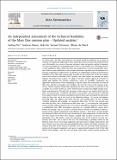| dc.contributor.author | Do, Sydney | |
| dc.contributor.author | Owens, Andrew Charles | |
| dc.contributor.author | Ho, Koki | |
| dc.contributor.author | Schreiner, Samuel Steven | |
| dc.contributor.author | de Weck, Olivier L. | |
| dc.date.accessioned | 2016-08-25T14:27:51Z | |
| dc.date.available | 2016-08-25T14:27:51Z | |
| dc.date.issued | 2015-03 | |
| dc.date.submitted | 2015-11 | |
| dc.identifier.issn | 00945765 | |
| dc.identifier.uri | http://hdl.handle.net/1721.1/103973 | |
| dc.description.abstract | In recent years, the Mars One program has gained significant publicity for its plans to colonize the red planet. Beginning in 2025, the program plans to land four people on Mars every 26 months via a series of one-way missions, using exclusively existing technology. This one-way approach has frequently been cited as a key enabler of accelerating the first crewed landing on Mars. While the Mars One program has received considerable attention, little has been published in the technical literature regarding the formulation of its mission architecture. In light of this, we perform an independent analysis of the technical feasibility of the Mars One mission plan, focusing on the architecture of the life support and in-situ resource utilization (ISRU) systems, and their impact on sparing and space logistics. To perform this analysis, we adopt an iterative analysis approach in which we model and simulate the mission architecture, assess its feasibility, implement any applicable modifications while attempting to remain within the constraints set forth by Mars One, and then resimulate and reanalyze the revised version of the mission architecture. Where required information regarding the Mars One mission architecture is not available, we assume numerical values derived from standard spaceflight design handbooks and documents. Through four iterations of this process, our analysis finds that the Mars One mission plan, as publicly described, is not feasible. This conclusion is obtained from analyses based on mission assumptions derived from and constrained by statements made by Mars One, and is the result of the following findings: (1) several technologies including ISRU, life support, and entry, descent, and landing (EDL) are not currently “existing, validated and available” as claimed by Mars One; (2) the crop growth area described by Mars One is insufficient to feed their crew; (3) increasing the crop growth area to provide sufficient food for the crew leads to atmospheric imbalances that requires a prohibitively large ISRU atmospheric processor or a notably different system architecture to manage; and (4) at least 13 Falcon Heavy launches are needed to deliver a portion of the required equipment to the Martian surface, a value that is at least double that planned by Mars One for the same mission phase. Most importantly, we find that the one-way nature of the Mars One mission, coupled with its plans to increase its crew population every 26 months, causes the operating costs of the program to grow continually over time. This is due to the fact that maintaining a growing colony on the Martian surface incurs increasing equipment and spare parts resupply requirements and hence launch costs over time. Based on published launch vehicle and lander estimates, our analysis finds that by the launch of the fifth crew, the cost associated with launching a portion of all required equipment and spares is approximately equal to half of the total NASA FY2015 budget – and this cost will grow when other critical systems outside the scope of this analysis are included. To mitigate these costs and bring the plan closer towards feasibility, we recommend a number of mission architecture modifications and technology development efforts be implemented before the initiation of any Mars settlement campaign. These include the further development of EDL, life support, and ISRU technologies, as well as additive manufacturing technology that utilizes ISRU-derived Martian feedstock as a potential means to address the growing cost of resupply. | en_US |
| dc.description.sponsorship | United States. National Aeronautics and Space Administration (NASA Grant NNX13AL76H) | en_US |
| dc.description.sponsorship | United States. National Aeronautics and Space Administration (NASA Grant NNX14AM42H) | en_US |
| dc.description.sponsorship | Josephine De Karman Fellowship Trust | en_US |
| dc.language.iso | en_US | |
| dc.publisher | Elsevier | en_US |
| dc.relation.isversionof | http://dx.doi.org/10.1016/j.actaastro.2015.11.025 | en_US |
| dc.rights | Creative Commons Attribution-NonCommercial-NoDerivs License | en_US |
| dc.rights.uri | http://creativecommons.org/licenses/by-nc-nd/4.0/ | en_US |
| dc.source | Elsevier | en_US |
| dc.title | An independent assessment of the technical feasibility of the Mars One mission plan – Updated analysis | en_US |
| dc.type | Article | en_US |
| dc.identifier.citation | Do, Sydney, Andrew Owens, Koki Ho, Samuel Schreiner, and Olivier de Weck. “An Independent Assessment of the Technical Feasibility of the Mars One Mission Plan – Updated Analysis.” Acta Astronautica 120 (March 2016): 192–228. | en_US |
| dc.contributor.department | Massachusetts Institute of Technology. Department of Aeronautics and Astronautics | en_US |
| dc.contributor.mitauthor | Do, Sydney | en_US |
| dc.contributor.mitauthor | Owens, Andrew Charles | en_US |
| dc.contributor.mitauthor | Ho, Koki | en_US |
| dc.contributor.mitauthor | Schreiner, Samuel Steven | en_US |
| dc.contributor.mitauthor | de Weck, Olivier L. | en_US |
| dc.relation.journal | Acta Astronautica | en_US |
| dc.eprint.version | Final published version | en_US |
| dc.type.uri | http://purl.org/eprint/type/JournalArticle | en_US |
| eprint.status | http://purl.org/eprint/status/PeerReviewed | en_US |
| dspace.embargo.terms | N | en_US |
| dc.identifier.orcid | https://orcid.org/0000-0002-7453-5046 | |
| dc.identifier.orcid | https://orcid.org/0000-0001-6677-383X | |
| dc.identifier.orcid | https://orcid.org/0000-0002-9527-7904 | |
| mit.license | PUBLISHER_CC | en_US |
| mit.metadata.status | Complete | |
